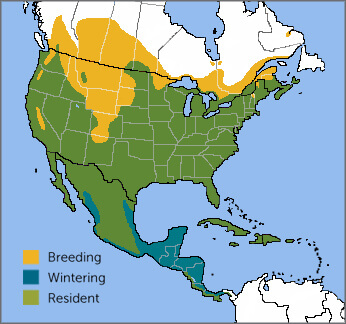
Mourning Dove range map by ABC
The handsome Mourning Dove is a familiar sight to most people — beige-brown above and pinkish-brown below, with black spots on its wings and an iridescent pink-and-blue flash on its neck. A ring of vivid blue skin encircles its large, dark eye.
Unlike the familiar Rock Pigeon, this member of the pigeon and dove family is native, as was the extinct Passenger Pigeon. The Mourning Dove is so distinctive that it can even be identified by silhouette, both perched and in flight: slim, long-winged, and small-headed, with a long, graduated tail. In fact, its species name macroura, from Greek, means “long tail.”
Hoots and Whistles
The Mourning Dove's soft call, which gives the bird its name, is a sad-sounding cooOOoo-woo-woo-woooo. Those unfamiliar with this plaintive, hooting vocalization often think they are hearing a Great Horned Owl or other owl species.
An interesting non-vocal sound of the Mourning Dove is the loud “whistle” made by its wings as it takes off and lands. As with the American Woodcock and Wilson's Snipe, air rushing through wing feathers produces these sounds. The dove's take-off and landing whistles serve as an alarm signal, warning other birds of potential dangers nearby. These sounds are also associated with the dove's courtship displays.
Listen here:
(Audio: Mourning Dove call by Jim Berry, XC407859. Accessible at www.xeno-canto.org/407859. Mourning Dove Wing-whistle by David Darrell-Lambert, XC476933. Accessible at www.xeno-canto.org/476933)
This widely distributed dove breeds from southern Canada south through the lower 48 U.S. states and Mexico to Panama, and also occurs in the West Indies. There are regular sightings in parts of northern Canada and southeastern Alaska as well, but breeding is scarce that far north. Northern populations tend to be migratory, wintering from the northern U.S. through southern Mexico.
Five subspecies of Mourning Dove are recognized, based on plumage variation, wing length, and bill and foot size.
Moving North
Most of the Mourning Dove's diet consists of grass, grain, and weed seeds. Like the Tufted Titmouse and Black-capped Chickadee, Mourning Doves are frequent visitors to backyard feeders, especially during the winter months. An abundance of food provided by humans may have helped the doves expand its range north.
The Mourning Dove, along with other pigeons and doves, is among the few birds that can drink using suction. Other birds must drink water by filling their bill with the liquid, then tilting their heads back, relying upon gravity to deliver water to swallow.

Mourning Dove on nest by YegoroV/Shutterstock
Milk-making Birds
When courting, a male Mourning Dove begins with a noisy takeoff, followed by a graceful, widely spiraling aerial display over the female. During the wide spirals, the streamlined and fixed-winged male can be mistaken for a small accipiter or falcon. After landing, the male struts before the female dove with a puffed-out breast and bobbing head. Mated Mourning Dove pairs form a strong bond that lasts the entire breeding season, and sometimes for life.
After pairing up, the male dove leads the female to potential nest sites in open habitats with scattered vegetation. She chooses one site. The Mourning Dove is not picky, and will nest in shrubs, vines, a wide variety of small trees, on building ledges, or in flower pots. The female builds a flimsy stick nest with help from her mate, who gathers and contributes nest materials. Nests may be so thin that the eggs can be seen from below.
The female usually lays two eggs, and both parents take turns incubating. The newly hatched young, known as squabs, are fed a special diet of crop milk regurgitated by their parents. This fat and protein-rich secretion of the crop lining sustains squabs during their first week of life, after which the parents switch to feeding them softened seeds. All pigeons and doves, as well as flamingos and the Emperor Penguin, produce crop milk for their young.
Research suggests that a pair of breeding doves cannot produce enough crop milk to feed more than two young, which explains why clutches are limited to that number. However, Mourning Doves can produce multiple clutches. In warm areas, one pair may raise up to six broods of two young in a single year.
A Gamut of Threats
The Mourning Dove's swift flight makes it a popular gamebird, and habitat is often created specifically for dove-hunting. Although dove harvests are generally kept at sustainable levels, spent lead shot poses a huge problem for these ground-feeding birds. Each year, millions of Mourning Doves accidentally ingest spent pellets and die slow, painful deaths from lead poisoning.
ABC encourages hunters and fishing communities to consider non-lead shot alternatives to protect doves and other species, such as the California Condor, Golden Eagle, and Common Loon.
While the Mourning Dove remains common throughout its range, it also faces the same threats as less-adaptable species, particularly predation by cats. ABC's Cats Indoors program, which encourages pet owners to keep cats and birds safe, is an effective way to address this threat.
Donate today to help us save Mourning Doves and their habitats throughout the Americas!



















































